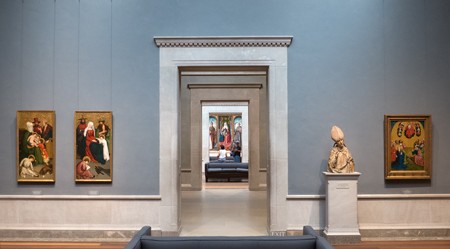From the beginning of the era of illustration, public interest in art has focused on painting, a bias that contemporary art is starting to correct. The religious character of most medieval sculpture contributed to this neglect. Sculptures not reused in churches or saved by early collectors and a few devotees were often burned as firewood. For a long time, only a few collectors went against the tide; among the first of these was Prince Ludwig of Oettingen-Wallerstein (1791–1870), to whose collection the National Gallery of Art owes its Holy Kinship (South German, fifteenth century).
It was only around 1900 that the prices for northern European late Gothic sculptures suddenly began to soar. One of the collectors recognized even then as a driving force behind this inflation of sculpture prices was Benoit Oppenheim. The heyday of collecting late Gothic sculpture lasted only a short time; Oppenheim bought most of the roughly one hundred forty sculptures in his collection between 1901 and 1911. Established in Königsberg (today Kaliningrad), Dresden, and Berlin and linked to the Mendelssohn-Bartholdy family by several marriages, the
Other aspects make Oppenheim a most unusual figure among the
collectors of his time. He described his collection in two lavishly published volumes that bear witness to his considerable connoisseurship. After World War I, Oppenheim’s works were not auctioned as a single lot but sold piecemeal, for even higher prices than he had paid for them. Several made their way to the United States, where museums and collectors assumed the role of principal purchasers of northern European sculptures after 1918. Two of Oppenheim’s works figure today among the highlights of the National Gallery of Art sculpture collection: A Bishop Saint (Burchard of Würzburg?), one of the best works by Tilman Riemenschneider (c. 1460–1531) in the United States, and the anonymous English alabaster group Saint George and the Dragon.
With the acquisition of the Bollert sculpture collection in 2004, the Bayerisches Nationalmuseum, Munich, became, together with the Skulpturensammlung in Berlin, the single largest owner of sculptures formerly in Oppenheim’s collection. In researching this acquisition, I soon realized that Oppenheim, as a unique and pivotal figure of collecting history, deserved much more attention than has hitherto been accorded him. Although very few of his personal papers seem to have survived, documents in various archives as well as many other dispersed records and objects still treasured by Oppenheim’s descendants—and, not least, the sculptures themselves—offered clues both to the circumstances under which he first formed and then dissolved his collection and to his biography and the role of his family in nineteenth-century Germany.
To turn the wealth of material amassed into a book is no easy task given the demands of a curatorial position. Therefore I am grateful to CASVA for offering me a unique chance to work for two months exclusively on the final stages of my Oppenheim monograph. Although my main focus was on finishing the text, the rich resources of the National Gallery of Art Library and image collections allowed me to consult material to which I had not previously had access. My stay in the United States also offered a very welcome
One chapter of my book will be devoted to Benoit’s uncle, the important early photographer Felix Alexander Oppenheim (1819–1898), and so it was exciting to trace four hitherto unknown Oppenheim photographs from the 1850s now at George Eastman House in Rochester and with a dealer in New York. Not least were additional findings concerning the former Oppenheim works now owned by the National Gallery of Art. The Duveen Brothers papers at the Getty Research Institute offered new insights into an important restoration carried out on the Riemenschneider bust, touching another central topic of my research: the way collecting affects the material state of objects. For advice and discussions on this archival work, I was very grateful to both Nancy Yeide and Alison Luchs, along with many other colleagues at the Gallery and CASVA who made my stay in Washington so pleasant and productive.
